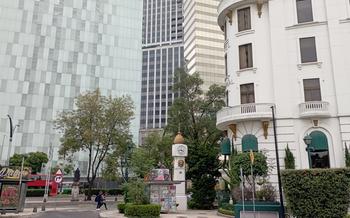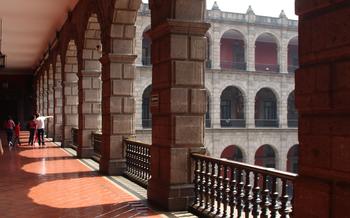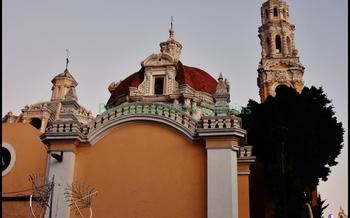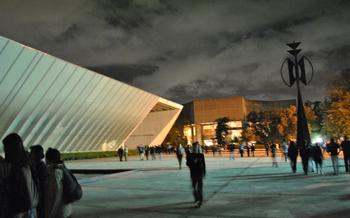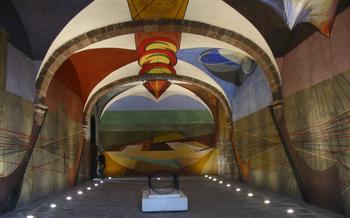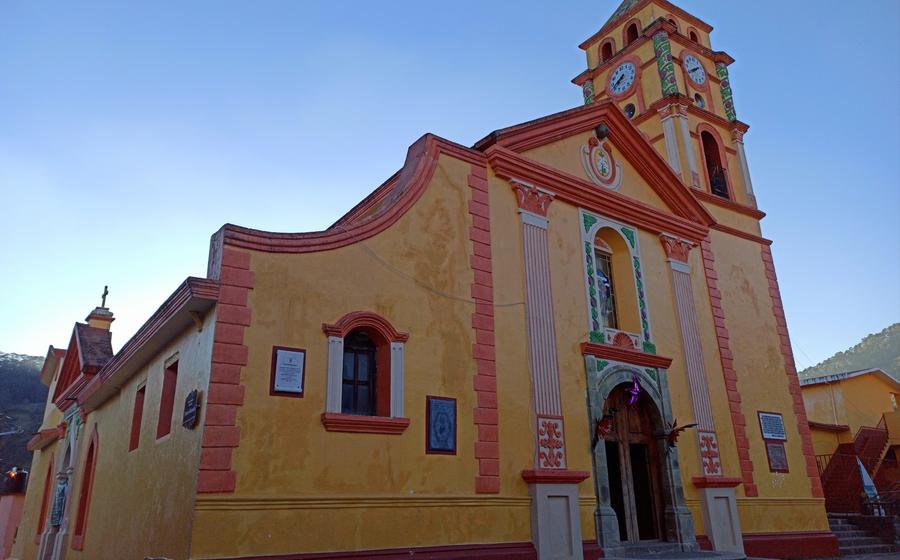
Querétaro's Autonomous University Art Gallery
- Querétaro’s Autonomous University Art Gallery
- A Brief History of the Gallery
- Navigating the Museum’s Unique Architecture
- A Diverse and Dynamic Collection
- Exploring Mexican Identity through Art
- Engaging with the Museum’s Educational Programs
- Unveiling the Stories Behind the Artworks
- Tips for Planning Your Visit
- Immersive Experiences for Art Enthusiasts
- Discovering Hidden Gems in the Collection
- Capturing the Essence of Querétaro’s Art Scene
- Accessibility and Inclusion Initiatives
- Traveling to and Around Querétaro
- Unforgettable Moments at the Gallery
- Insider Tip: Unveiling the Hidden Courtyard
Querétaro’s Autonomous University Art Gallery
Querétaro’s Autonomous University Art Gallery is a renowned institution dedicated to preserving and showcasing the rich artistic heritage of Mexico. Located in the heart of Querétaro City, this gallery offers a diverse collection of artworks, temporary exhibitions, and educational programs that captivate visitors from around the world.
History
The gallery was founded in 1983 as part of the Querétaro’s Autonomous University and has since become a prominent cultural institution in the region. Originally housed in a colonial-era building, the gallery moved to its current location in 2006, a modern and spacious facility designed to accommodate its growing collection and educational initiatives.
Location
The gallery is situated on the university campus, within walking distance of the historic center of Querétaro City. Its strategic location makes it easily accessible for both university students and the general public, inviting visitors to explore the vibrant art scene of this UNESCO World Heritage Site.
Collection
The gallery’s collection encompasses over 1,000 artworks, ranging from pre-Columbian artifacts to contemporary installations. Highlights include masterpieces by renowned Mexican artists such as Diego Rivera, José Clemente Orozco, and Frida Kahlo, as well as international artists like Pablo Picasso and Salvador Dalí.
Hours and Admission
The gallery is open to the public Tuesday through Sunday, with extended hours on Thursdays. Admission is free of charge, making it an accessible destination for art enthusiasts and casual visitors alike.
A Brief History of the Gallery
The Querétaro’s Autonomous University Art Gallery stands as a testament to the city’s rich artistic heritage and its commitment to promoting cultural expression. Its history is intertwined with the evolution of Querétaro itself, reflecting the city’s transformation from a colonial outpost to a vibrant metropolis. The gallery’s architectural style, originally conceived in the Neoclassical tradition, has undergone several renovations and expansions over the years, mirroring the city’s architectural evolution. Initially envisioned as a space to showcase the works of local and regional artists, the gallery’s collection has expanded to include a diverse range of artworks from across Mexico and beyond. Through its exhibitions and educational programs, the gallery has played a pivotal role in fostering an appreciation for art and culture among the people of Querétaro.
Navigating the Museum’s Unique Architecture
The Querétaro's Autonomous University Art Gallery is a captivating space that invites visitors to embark on a journey through its innovative architecture. The gallery's design, led by renowned architect Luis Barragán, showcases a harmonious blend of traditional Mexican elements with modern, functional lines. Upon entering, visitors are greeted by a striking central atrium, which serves as the gallery's heart and provides access to various exhibition spaces. The atrium features a majestic staircase that leads to the upper levels, creating a sense of grandeur and inviting visitors to explore further.
The gallery's layout is well-organized and easy to navigate, ensuring that visitors can seamlessly transition from one exhibition to another. Wide corridors and open spaces allow for comfortable movement and provide ample room to admire the artworks without feeling crowded. The gallery also prioritizes accessibility, featuring ramps, elevators, and accessible restrooms, ensuring that all visitors can fully experience and appreciate the exhibited masterpieces.
A Diverse and Dynamic Collection
The Querétaro's Autonomous University Art Gallery houses a diverse and dynamic collection that showcases a wide range of artistic styles, techniques, and genres. The permanent collection boasts over 2,000 artworks, including paintings, sculptures, drawings, engravings, and photographs. Among the highlights are works by renowned Mexican artists such as Saturnino Herrán, José María Velasco, and Diego Rivera.
In addition to the permanent collection, the gallery also hosts a variety of temporary exhibitions throughout the year. These exhibitions often feature the work of emerging and established artists from Mexico and abroad, as well as thematic or historical exhibitions that explore different aspects of Mexican art and culture. Notable past exhibitions have included retrospectives on the work of Frida Kahlo and David Alfaro Siqueiros, as well as exhibitions on the history of Mexican muralism and the influence of pre-Columbian art on contemporary Mexican art.
Exploring Mexican Identity through Art
The Querétaro's Autonomous University Art Gallery serves as a platform to showcase the rich tapestry of Mexican culture through the lens of art. The permanent collection and temporary exhibitions feature a wide range of artworks that delve into the complexities of Mexican identity. Visitors can explore the representation of indigenous traditions, colonial influences, and contemporary social and political issues through diverse artistic expressions. The gallery invites visitors to engage with the intricacies of Mexican culture, fostering a deeper understanding and appreciation of its vibrant heritage.
Engaging with the Museum’s Educational Programs
The Querétaro's Autonomous University Art Gallery offers a wide range of educational programs designed to engage and inspire visitors of all ages. These programs provide an opportunity to delve deeper into the world of art, gain insights into the creative process, and develop a greater appreciation for the rich cultural heritage of Mexico.
Workshops and classes are conducted regularly, allowing participants to learn various art forms and techniques under the guidance of experienced instructors. From painting and sculpture to printmaking and photography, these workshops offer a hands-on approach to artistic expression, enabling participants to unleash their creativity and explore their own artistic potential.
Guided tours are available to provide visitors with a comprehensive overview of the gallery's collection and temporary exhibitions. Led by knowledgeable guides, these tours offer insightful commentary on the artworks, their historical context, and the artistic movements they represent. Visitors can gain a deeper understanding of the creative process, the symbolism embedded in the artworks, and the cultural influences that have shaped Mexican art.
Interactive exhibits are designed to engage visitors in a dynamic and immersive learning experience. These exhibits often incorporate multimedia elements, hands-on activities, and interactive installations that allow visitors to explore the artworks in a multi-sensory way. By encouraging active participation and discovery, these exhibits foster a deeper understanding of the artistic concepts and techniques employed by the artists.
Unveiling the Stories Behind the Artworks
The Querétaro's Autonomous University Art Gallery houses a wealth of stories waiting to be unveiled. Each artwork carries with it a unique narrative, revealing the artist's inspiration, the historical context, and the cultural significance behind its creation. By delving deeper into these stories, visitors can gain a profound appreciation for the artworks and the artistic process itself.
Artist Profiles:
Discover the lives and journeys of the talented artists whose works grace the gallery's walls. Learn about their artistic styles, influences, and motivations through detailed profiles that shed light on their creative vision.
Historical Context:
Explore the historical backdrop against which the artworks were created. Understand how social, political, and cultural factors shaped the artists' perspectives and influenced the themes and subjects they chose to depict.
Behind-the-Scenes Stories:
Uncover the fascinating stories behind the scenes of the artworks. Learn about the techniques and materials used, the challenges faced by the artists, and the inspiration that sparked their creativity.
Tips for Planning Your Visit
Before embarking on your art adventure at the Querétaro’s Autonomous University Art Gallery, it's essential to plan your visit to ensure a smooth and enriching experience. Here are some tips to help you make the most of your journey:
-
Best time to visit: To avoid crowds and fully immerse yourself in the gallery's ambiance, consider visiting during weekdays, particularly in the morning or late afternoon. This will allow you to explore the artworks at your own pace and engage with the staff for personalized insights.
-
Advance planning and reservations: To make the most of your time and avoid any inconvenience, check the gallery's website or contact them in advance to confirm their hours of operation and inquire about any special events or exhibitions that may be taking place during your visit. Reservations for guided tours or workshops are highly recommended, especially if you're traveling with a group or have specific interests.
-
Guided tour options: Guided tours are an excellent way to delve deeper into the history, significance, and stories behind the artworks. The gallery offers a variety of guided tours led by knowledgeable and passionate educators who can provide you with a more comprehensive understanding and appreciation of the collection. Tours are available in Spanish and English upon request.
Immersive Experiences for Art Enthusiasts
The Querétaro's Autonomous University Art Gallery provides a platform for innovative and immersive art experiences that captivate art enthusiasts. Among the highlights are interactive art installations that invite visitors to engage with the artworks in a hands-on manner. These interactive exhibits often feature cutting-edge technologies that allow visitors to manipulate and explore the art in real-time, creating a truly immersive and memorable experience.
Multi-sensory exhibits are another highlight of the gallery, offering visitors a unique and immersive way to experience art. By incorporating elements such as sound, scent, and tactile sensations, these exhibits create a multi-layered sensory experience that engages the audience on a deeper level. Visitors can explore these multi-sensory installations, allowing the artworks to transport them to different worlds and evoke a range of emotions.
Performance art events are periodically hosted at the gallery, providing a platform for artists to showcase their talents and create live, interactive experiences for the audience. These events often feature experimental and thought-provoking performances that challenge traditional notions of art and push the boundaries of artistic expression. Visitors can witness these live performances, gaining a unique insight into the creative process and the artist's vision.
Discovering Hidden Gems in the Collection
Beyond the renowned masterpieces, the gallery also houses a treasure trove of lesser-known artworks that offer unique perspectives and insights into Mexican art. Delve deeper into the collection to uncover hidden gems that may resonate with your personal tastes or provide a fresh perspective on Mexican culture.
Look for works by emerging or underappreciated artists who may not have received widespread recognition but whose talent and creativity shine through. These hidden gems often offer a glimpse into the diverse and dynamic nature of Mexican art, showcasing the country's rich cultural heritage and the boundless creativity of its artists.
Take the time to explore the nooks and crannies of the gallery, where you may stumble upon unexpected treasures that capture your attention and imagination. Whether it's a small-scale sculpture nestled in an alcove or a thought-provoking painting hanging in a quiet corner, these hidden gems can provide a profound and memorable experience.
Embrace the opportunity to discover the hidden depths of the gallery's collection, and you may just find yourself uncovering a new favorite artwork or gaining a deeper appreciation for the diverse and multifaceted nature of Mexican art.
Capturing the Essence of Querétaro’s Art Scene
Querétaro's Autonomous University Art Gallery is deeply intertwined with the local art scene, serving as a vibrant platform for showcasing and promoting contemporary Mexican art. The gallery collaborates closely with local artists, providing them with a space to exhibit their works and engage with the community. Through its exhibitions, the gallery reflects the diverse artistic expressions that define Querétaro's dynamic art scene. Additionally, the gallery maintains connections with other cultural institutions in the city, fostering a collaborative environment that enriches the cultural landscape of Querétaro. The gallery also actively participates in art fairs and festivals, showcasing the works of its artists to a broader audience and contributing to the city's vibrant cultural calendar.
Accessibility and Inclusion Initiatives
The Querétaro’s Autonomous University Art Gallery is committed to providing an accessible and inclusive environment for all visitors. The gallery features wheelchair ramps, elevators, and accessible restrooms, ensuring that individuals with disabilities can fully experience and enjoy the museum's offerings. Additionally, the gallery offers educational programs tailored for diverse audiences, including guided tours in sign language, audio descriptions for visually impaired visitors, and sensory-friendly tours for individuals with autism or other sensory sensitivities. Through these initiatives, the gallery strives to create a welcoming and inclusive space where everyone can engage with and appreciate the transformative power of art.
Traveling to and Around Querétaro
Querétaro is conveniently accessible by various transportation means, making it easy to reach the Querétaro's Autonomous University Art Gallery. The city is well-connected by air, with flights from major cities in Mexico and international destinations. Querétaro Intercontinental Airport is approximately 25 kilometers from the city center and offers a range of transportation options to reach the gallery. Once in Querétaro, visitors can choose from a variety of public transportation options, including buses and taxis, to get around the city. To reach the gallery specifically, visitors can take a short bus ride from the city center or opt for a scenic walk to enjoy the city's colonial architecture and vibrant atmosphere.
Querétaro is a city rich in history and culture, offering numerous attractions and activities for visitors. The city center is home to well-preserved colonial buildings, including the iconic aqueduct, churches, and museums. Visitors can explore the city's vibrant art scene by visiting other galleries and museums, such as the Museum of Contemporary Art and the Regional Museum of Querétaro. The city also offers a variety of parks and gardens, providing opportunities for relaxation and outdoor activities. Querétaro's proximity to other popular destinations, such as San Miguel de Allende and Guanajuato, makes it an ideal starting point for exploring the region's cultural and historical treasures.
Unforgettable Moments at the Gallery
Stepping into the Querétaro's Autonomous University Art Gallery, I was captivated by the interplay of light and shadow, the whispers of art enthusiasts, and the sense of wonder that permeated the air. As I wandered through the galleries, each artwork seemed to tell a story, inviting me to delve deeper into its history and significance.
One moment that stands out vividly is encountering a painting by a local artist depicting a vibrant street market scene. The canvas was alive with colors, textures, and the hustle and bustle of everyday life. I could almost hear the laughter of the vendors, the chatter of the crowd, and the distant melodies of traditional music. It was a moment of pure immersion, where I felt transported to another time and place.
In another gallery, I stumbled upon a multimedia installation that combined video projections, sound effects, and interactive elements. The piece explored the theme of identity and belonging, inviting viewers to contemplate their own sense of self in relation to their community and the wider world. As I engaged with the installation, I felt a profound connection to the artist's message and the emotions it evoked.
The Querétaro's Autonomous University Art Gallery is more than just a repository of artworks; it is a space where history, culture, and creativity converge. Each visit promises a unique and unforgettable experience, leaving visitors with lasting memories and a deeper appreciation for the power of art.
Insider Tip: Unveiling the Hidden Courtyard
Venture beyond the main galleries to discover a hidden gem—the gallery's serene inner courtyard. This tranquil oasis offers a respite from the bustling museum, inviting visitors to pause and reflect amidst the beauty of nature. Take a moment to sit on one of the benches, surrounded by lush greenery and the gentle sound of trickling water. Soak in the tranquility, let your thoughts wander, and appreciate the harmony between art and nature that this special space exudes.
